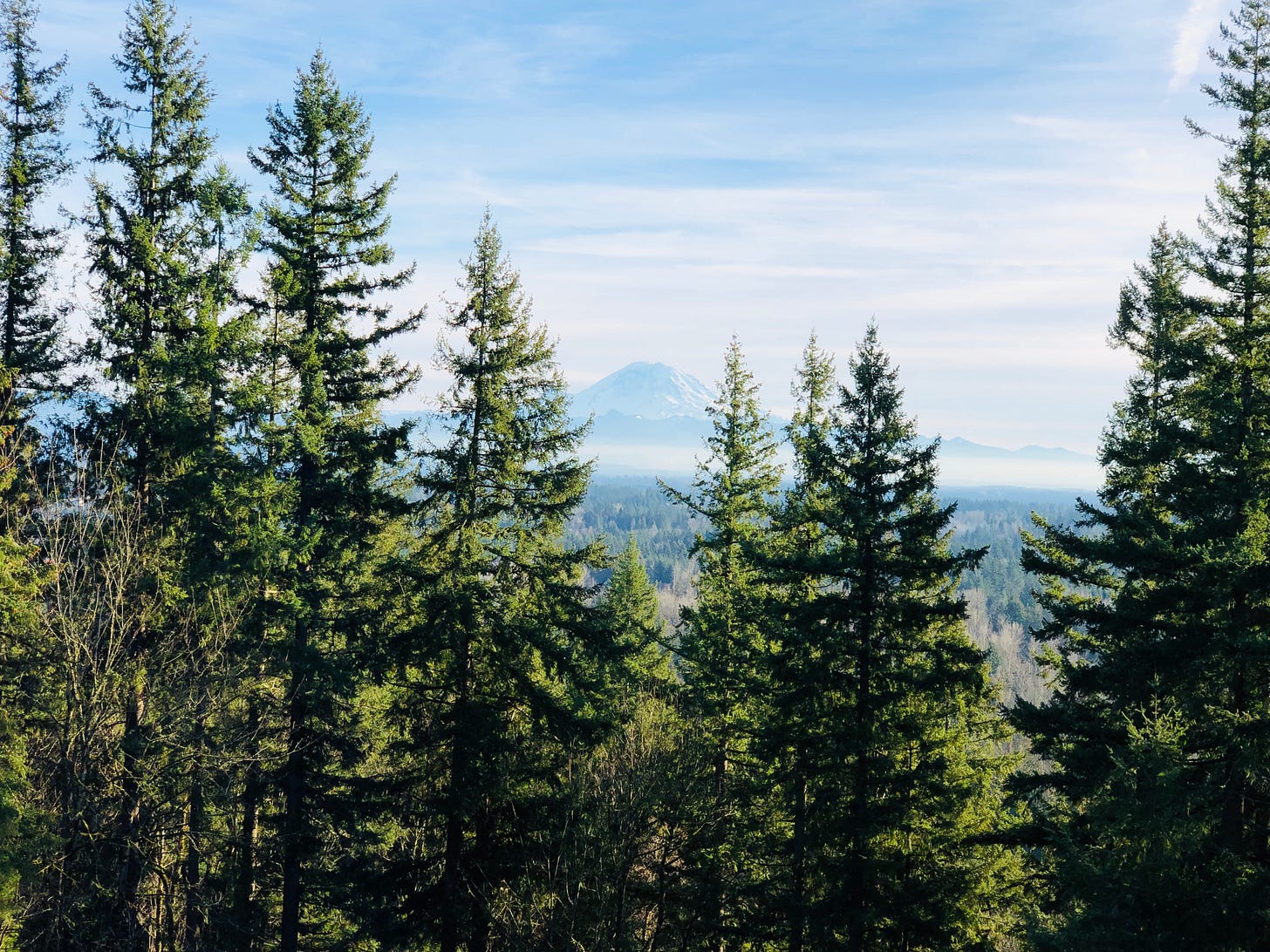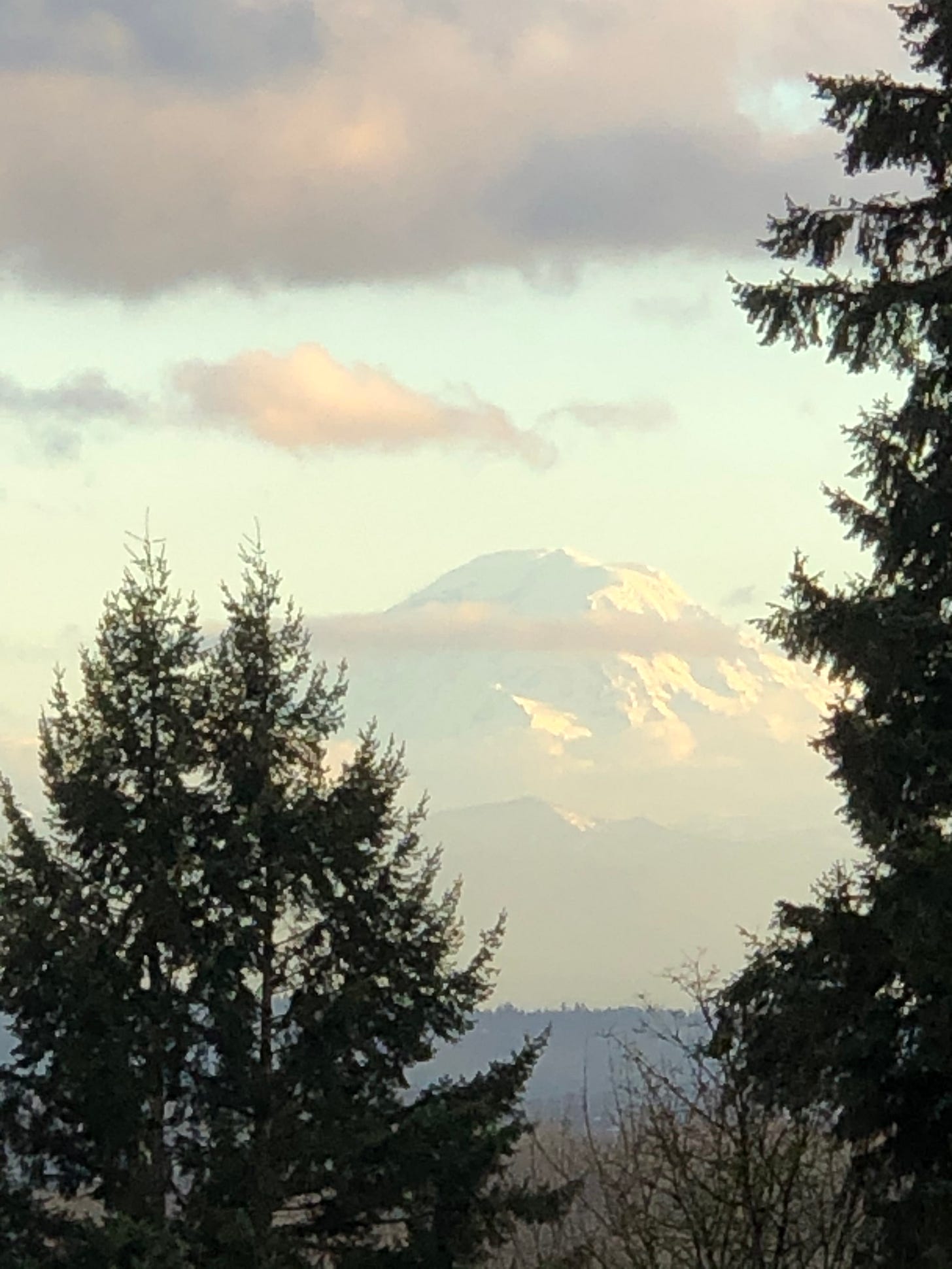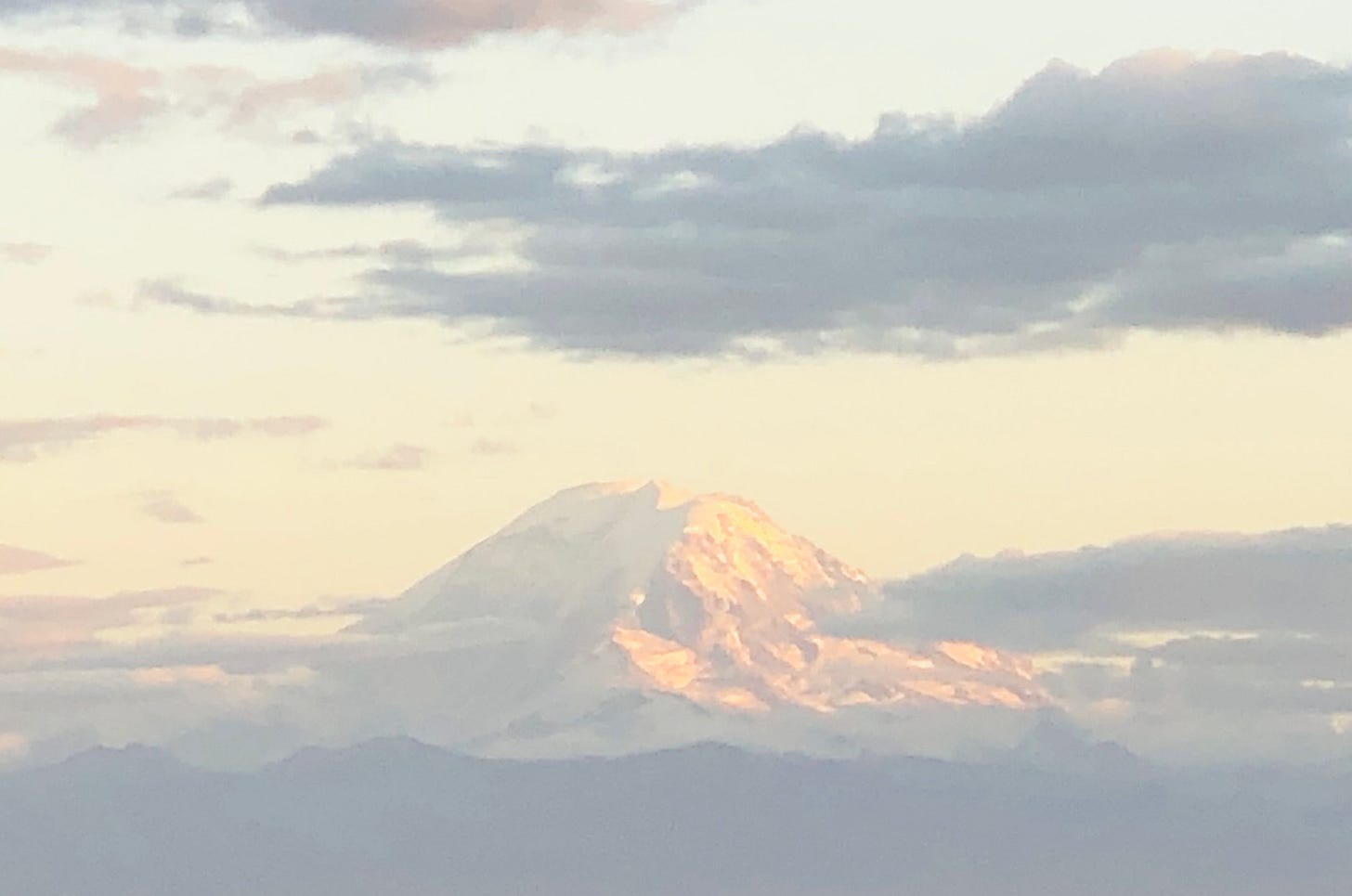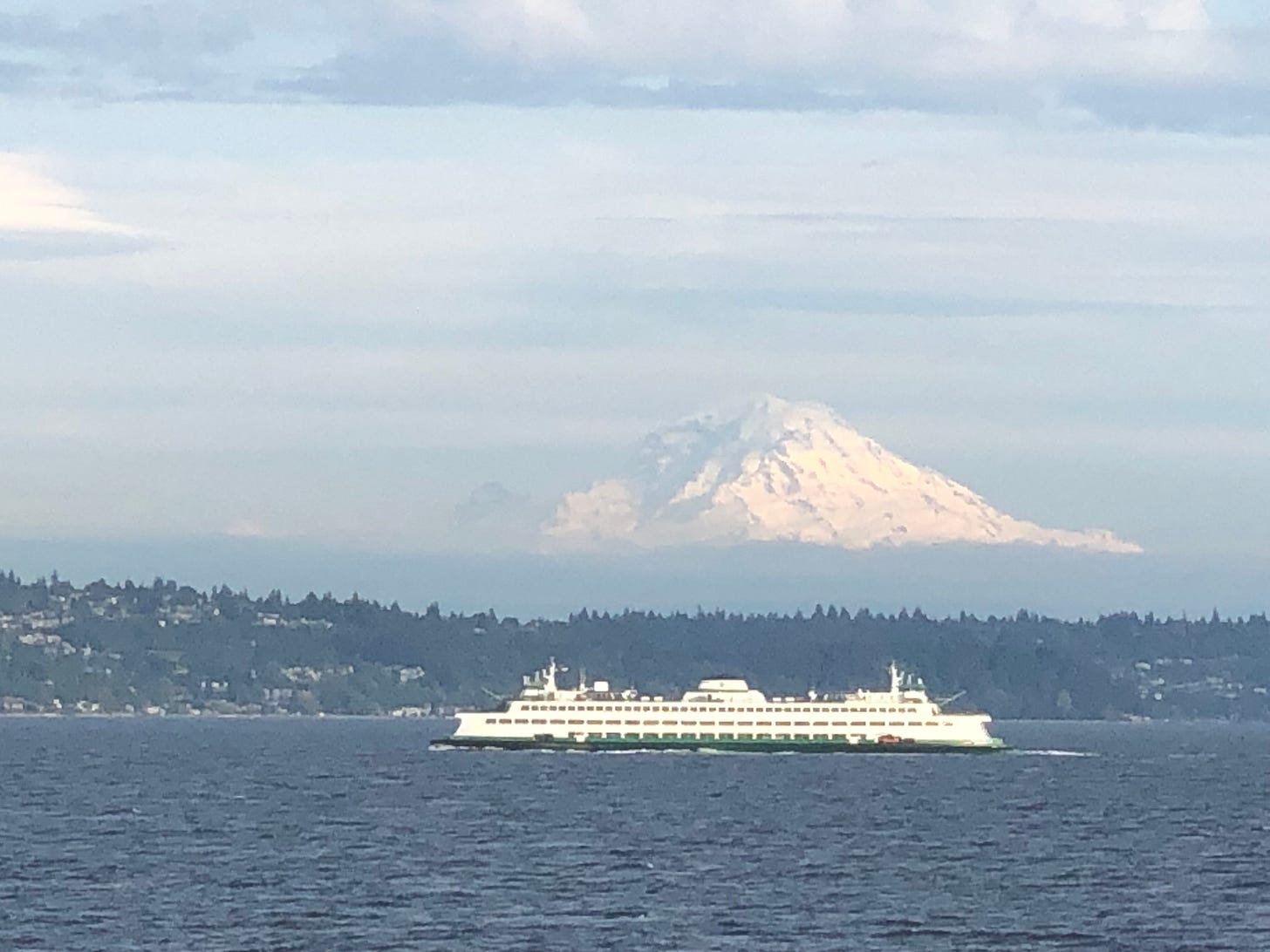Mother of All Waters
A love story.
The earth is a living thing. Mountains speak, trees sing, lakes can think, pebbles have a soul, rocks have power. ~ Henry Crow DogIf you’ve ever fallen head over heels for a lilting landscape or vast vista, shoreline kissed by ocean salt, precariously-perched rookery or sky-seeking Sequoia, colossal Cedar, fern-flanked path or field of flowers where you least expect it and need it most—this post is for you.
Eleven years ago when I made the decision to move south of Seattle after many years contentedly living in the north end, I had my qualms. I won’t bore you with the laundry list of heady hesitations but I’ll never forget the afternoon they dissipated.
It was early spring and one of the first cloudless days we’d had in a long (long) rainy while. I was trekking south in bumper-to-bumper traffic, my car teetering high with moving boxes. You know how that goes, exhausting. Suddenly there she was, shimmering prominently in all her incandescent ice-capped glory on the highway horizon: the iconic Pacific Northwest mountain many of us know, frequently featured on posters and postcards. Her glaciated sunlit peaks so breathtaking, it was difficult not to swerve off the road in my distraction.
In that instant it crystalized: If moving south meant I would be closer to her, it was hard to object.
The very first thing that happened is I stopped calling her Mount Rainier. I decided to restore her personal salutation (“expression of praise and admiration”) to the one she has carried since time immemorial. It turns out the modern-day moniker we rely upon was a nod from one military man to another on a 1792 mapping expedition, and Rear Admiral Peter Rainier Jr. never once laid his own eyes (or feet) anywhere near the orbits of this spectacular summit.
By contrast, the indigenous peoples past and present of Washington’s Puget Sound region have long referred to this majestic mountain as “təqʷuʔməʔ”—or Tahoma, also pronounced as Taquoma. In the Central Coast Salish language of Lushootseed, this word associates with the mountain’s inspiring beauty and water-bestowing presence in their lives and cultures. “Ta” meaning “larger/taller” is apt given her eminence in the Cascade Mountain Range. Her name of origin has also lyrically been interpreted as the “mother of waters” or “mother of all waters” as well as “Supreme Mountain,” “breast of the milk-white waters,” “frozen water,” and suitably “snowy mountain.” All worthy descriptors befitting her steep grandeur.
Next I learned that she is estimated to be over 500,000 years old. So not only the mother of all waters, but grandmother of all grandmothers. An ancient matriarch with wisdom to impart.
Given my recent gravitation toward deep time, I am awed and humbled by the sheer breadth of that many lived years. I try to conceptualize, and cannot, all she has witnessed since the days of her early emergence, including the now only-fossilized flora and fauna who came before us.
When I gaze at her visage with this newly acquired knowledge, I see her differently. I consider the infinitesimal triumphs and tragedies buried beneath her snowfields, a cardinal component of her lyrical and long-layered life. What bright-eyed creatures swam and slithered, clamored and crept, wove and wept across her alpine lakes and tundras bursting with wildflowers? Whose secrets have been lost and found in the craggy snags of emerald evergreens, or etched into extinction and forever forgotten in her shivery ice caves? She’ll never tell.
You can understand, then, my delight when I happened upon one such long-ago chronicle featured on a Mountaineers' blog advocating stridently for her name to be restored:
“[She]...carries...the invaluable narratives of the first people of this land including one in which a great flood threatened the lives of people and other animals in the region who were only able to survive by scrambling to the top of the peak and remaining there together until the waters subsided. For mountaineers and others in this area, Tahoma continues to be a place of refuge from the many problems that flood our minds and our society today.” ~ Cooper WeissmanThe author’s visual of the literal and figurative life-raft provided to countless living beings by this beloved mountain is visceral for me. As is his vivid use of the term “place of refuge” which Tahoma—like myriad other still-intact and pristine wild spaces and places enduring across the planet—offer so many of us drowning in the societal and terrestrial deluges of the warming modern day.
Interestingly, my love affair with this mountain is primarily a visual one. Strange as it may sound, the distance between us has been an endearing enhancement—not a detraction.
Close as she appears in my camera’s lens, reaching her foothills is in reality a circuitous two-hour-plus drive that I’ve taken only once in recent years. Like so many other national parks she is already overburdened with visitors holding crinkled trail maps and cameras. So much so that park officials have had to implement timed entry reservations and establish “overuse limits” for her most popular nooks and crannies. This gives me pause.
If anything, the human-imposed limitation has only made my heart grow fonder. I empathize with her encumbrance and have the distinct sense that it’s reciprocal. An ecologically healing concept I’ve touched on before. Poet Laureate Ada Limon has written about it zealously, espousing that when we witness (“to see, be present with, or to know first-hand”) Earth, we are actually being witnessed in response. It’s a perspective that has opened up whole new realms for me, especially when I am grieving a newly razed forest or precious species on the brink in our ever-urbanizing world.
Australian writer Susan Murphy Roshi relayed something similar in a compelling interview about the moment her home was threatened by a catapulting and catastrophic wildfire. When she fell to her knees before the blaze, digging her fingers into the soil of the land she hoped to save (and did!), she heard Mother Earth saying, “Your suffering with me is my care for you.” I haven’t yet found a better way to articulate the mysterious mutuality.
Reciprocity has such resonance. It embodies a “seen” interdependence and the full comprehension of a harmonious and complementary relationship. Because I too believe our interactions with the intricately-spun web of creation—of which we are a part—are meant to be a conversation in the round, as Henry Crow-Dog eloquently alludes to. True exchanges, and relationships, necessitate both parties.
They are not a one-way discourse or right of possession.
Meanwhile everywhere I go, there she is.
Eclipsing the southern skyline, changing colors by the hour. Shape-shifting with the sun and seasons as she sidles up or cavorts around a corner and disappears from view. Bejeweled one day with cloud crowns and condensation capes; stark and snow-bare the next. Steadfastly herself while ever-morphing minute to minute, never again exactly the same. Just like us. An embodiment of contrasts: an active volcano capable of cataclysmic conflagration sitting serenely in a sea of sky with all the time in the world to while and wait. Half a million years to put a point on it.
Sometimes her ancient allure is so magnetic, I will pull over in traffic—or just about anywhere else I might find myself when she appears—to snap a photo and take a breath in worship and wonder. Lost in love.
Watching me watch her; watching her watch me.
“Let the beauty we love be what we do.” ~ RumiIn the spirit of reciprocity, I’d welcome hearing your own Living Earth love story. We all have them, and they undergird our lives in meaning and mutuality. What would happen if we gave these loves, and their impact, more reign in our lives?





Oh my goodness. THIS. I think I am in love with her too. ❤️
Lovely. And I'm so glad you mentioned reciprocity as the foundation of the relationship. Yes!